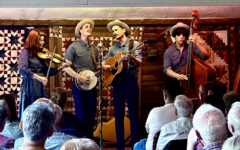
 We all know the story of how bluegrass came to Ireland—how Bill Monroe banished the dreadful snakes and taught three-part harmony with a shamrock.
We all know the story of how bluegrass came to Ireland—how Bill Monroe banished the dreadful snakes and taught three-part harmony with a shamrock.
While some may doubt the accuracy of this account, none can dispute the fact that in the Island of Saints and Scholars, bluegrass music is alive and flourishing.
For this column (posted in two parts, today and tomorrow), I asked two Irish champions of bluegrass—Richard Hawkins and Ronnie Norton—for their thoughts on St. Patrick’s Day 2012. My thanks to both for their thoughtful answers.
What better way to celebrate St. Patrick’s Day than to listen to a couple of Irishmen wax eloquent? So, pour up a pint of Guiness and enjoy.
Richard Hawkins is the editor of the Bluegrass Ireland Blog and active champion and player of bluegrass in Ireland. He was editor of the Irish Bluegrass Music Club Newsletter and Bluegrass Ireland newsletter 1996–2007, and is a member of IBMA, IBMM, EBMA, and BBMA (or apparently anything else with a 4-letter initialism. I tried to sign him up for ESPN and the NCAA).
CS: Is there a difference in how we Americans celebrate St Patrick’s Day vs. how the Irish celebrate it? Do the Irish think Americans go too far in pretending to be Irish every March 17?
 RH: One difference is clearly that if you’re born in Ireland and living there, not only do you have 365 days a year to be Irish in, but there are numerous other opportunities of expressing Irishness, if that’s what you want to do. Plus, practically everyone round you is also Irish, so asserting that fact on one particular day doesn’t seem quite such a big deal. To whom (or against whom) are you asserting your Irishness? When the whole of Ireland was under British control, there was a political reason among nationalists for celebrating St. Patrick’s day, but that lost some of its steam after independence.
RH: One difference is clearly that if you’re born in Ireland and living there, not only do you have 365 days a year to be Irish in, but there are numerous other opportunities of expressing Irishness, if that’s what you want to do. Plus, practically everyone round you is also Irish, so asserting that fact on one particular day doesn’t seem quite such a big deal. To whom (or against whom) are you asserting your Irishness? When the whole of Ireland was under British control, there was a political reason among nationalists for celebrating St. Patrick’s day, but that lost some of its steam after independence.
Added to which, for the first fifty years or so of independence there was not a great deal of public or private money to spare. Ireland was poor by British standards, let alone American; so even if the scale and style of St. Patrick’s day parades in the US had not seemed ‘outlandish’, they could not have been emulated. Speaking for myself and Carol, when our children were small we all went into Dublin to see the parades, and as far as the weather would let us we enjoyed them; but I remember them mostly as demonstrating what could be done with sparse resources, and the American high school marching bands that provided the main elements of colour and drama were clearly on a different scale from most other groups parading.
However, I think that all the time the ideas were incubating that, ‘outlandish’ or not, it was some kind of credit to Ireland that the US celebrations were so big, and that it was also a pity that the celebrations here fell so far below that standard. And since money began to be more available in the late ’80s and ’90s, the St. Patrick’s day parade in Dublin has been transformed out of all recognition. You can now see moving displays, spectacle, and street theatre on a grand scale that owe something not only to US example but to the example of carnivals elsewhere, with buckets of local creative imagination and of course the use of themes from Irish mythology and history, and so on. So I’d say that while in earlier years people in Ireland viewed the US celebrations like poor relations viewing the exuberance of their wealthy cousins, they are now doing what they can to match it.
CS: How have most Irish fans of bluegrass come to the music?
RH: Different ways; I can’t really say which predominates. Many come though country music, which is popular here. One of the lead singers in the band I’m in (he also plays Irish traditional music, though not with our band) has a great stock of country songs from the ’30s through the ’50s. We play a lot in country towns and villages, and there are often local singers with similar tastes. The other day, coming back from a jam in town by the new tram system, I found that the ticket inspector was a devout country music fan with thousands of CDs and DVDs.
A growing number come from traditional music, because they know of bluegrass as a music with similar qualities to theirs and are intrigued by its different qualities and different demands, and/or have seen Tim O’Brien, Alison Krauss, Ricky Skaggs, or Jerry Douglas playing with the Chieftains or other people.
Some, no doubt, are like myself in being oddballs who are attracted by anything that’s not mainstream, or came to it through the folk music movement (so far as those two things are distinguishable). It is certainly easier nowadays to hear bluegrass on the radio, thanks to broadcasters like Niall Toner, Ronnie Norton, Sandy Harsch, and others on the national and local radio stations.
CS: Is there an argument in Ireland over what is or isn’t bluegrass?
RH: Not a big one; really it’s only a small sub-department of the big argument you have in the US, and confined to the very few people with something like an informed opinion on the matter. There’s the same kind of public vagueness you’ll be familiar with, where ‘bluegrass’ may be used for any kind of acoustic Americana; but arguments don’t really arise from that, as though people may not know exactly what ‘bluegrass’ is, they seem to have a general impression that it’s benign. Those of us with more definite views don’t want to disturb that attitude.
Fans in Northern Ireland tend to hold stronger opinions on the matter, and you may be more likely to find what I’d call a ‘fundamentalist’ attitude up there. The band I’m in once played some sets at the Omagh festival, and after one of them a man came up to me and asked (not unkindly) what we called the kind of music we play – it wasn’t that he didn’t know bluegrass, but he thought the proportion of older country songs in our repertoire compromised our entitlement to be considered bluegrass.
CS: What are some of the more famous venues and festivals?
RH: The Athy Bluegrass Festival in Athy, Co. Kildare, founded in 1991, is the oldest annual bluegrass event in Ireland, and gave a great boost to the scene here. The Appalachian & Bluegrass Music Festival at the Ulster American Folk Park in Omagh, Co. Tyrone, Northern Ireland, was founded the following year, and is certainly the biggest of our events – indeed, crowds of about 10,000 over the weekend make it probably the biggest paying-in bluegrass event in Europe. The Guinness International Bluegrass Music Festival in Dunmore East, Co. Waterford, followed in 1995 and was the first to bring in quality bands from continental Europe, with no admission charges at all. The Johnny Keenan Banjo Festival began in 2002 and is unique for combining both Irish and American music with a top-class lineup in both (e.g. Earl Scruggs in 2004, on his first European trip for decades, and Béla Fleck the following year). The Westport Folk & Bluegrass Festival in the far west of Co. Mayo began in 2006. They’re the backbone of the specifically bluegrass-related festival season; a new festival in Tramore, Co. Waterford, is coming in June this year.
This isn’t what you asked about, but it’s becoming a part of the scene: there is also a growing number of weekend bluegrass mini-festivals, usually based on a single pub or hotel, or a couple of pubs cooperating in a small town, with three or four bands playing during a weekend. The example was set by John Murphy, harmonica player and owner of Colfer’s pub in the small village of Carrig-on-Bannow, Co. Wexford, when in 2005 he made a show by the Special Consensus the focal point of a weekend event. And there are also larger ‘roots music’ festivals that may have bluegrass-related acts, such as the Kilkenny Roots Festival in May or the Open House Festival in Belfast in June, not to mention the multi-genre Shannonside Winter Music Weekend in January and other regional arts festivals throughout the year.
Venues: there’s an established circuit of pubs with a reputation as venues for most kinds of music. The main ones for bluegrass purposes recur time and again in the calendar pages of the Bluegrass Ireland Blog. Local arts centres, which are likely to have well equipped auditoriums and attentive audiences, are also very important. For instance, the Village Arts Centre in Kilworth, Co. Cork, a former protestant church which can hold about 100 people. J.D. Crowe & the New South played there in 1999 and were impressed, and many bands such as the Special Consensus have also played there. The Seamus Ennis Cultural Centre in Naul, north Co. Dublin, the Bronte Music Club in Co. Down, and the Glens Centre in Co. Leitrim have also been very hospitable to bluegrass music.
continued…







